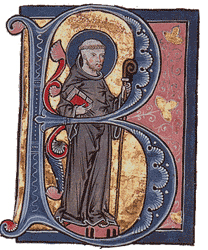
Anglicanism is a Western Christian tradition that has developed from the practices, liturgy, and identity of the Church of England following the English Reformation, in the context of the Protestant Reformation in Europe. It is one of the largest branches of Christianity, with around 110 million adherents worldwide as of 2001.

A nun is a woman who vows to dedicate her life to religious service, typically living under vows of poverty, chastity, and obedience in the enclosure of a monastery or convent. The term is often used interchangeably with religious sisters who do take simple vows but live an active vocation of prayer and charitable works.

The Society of Saint Francis (SSF) is an international Franciscan religious order within the Anglican Communion. It is the main recognised Anglican Franciscan order, but there are also other Franciscan orders in the Anglican Communion.

Anglican religious orders are communities of men or women in the Anglican Communion who live under a common rule of life. The members of religious orders take vows which often include the traditional monastic vows of poverty, chastity and obedience, or the ancient vow of stability, or sometimes a modern interpretation of some or all of these vows. Members may be laity or clergy, but most commonly include a mixture of both. They lead a common life of work and prayer, sometimes on a single site, sometimes spread over multiple locations.

There are a number of Benedictine Anglican religious orders, some of them using the name Order of St. Benedict (OSB). Just like their Roman Catholic counterparts, each abbey / priory / convent is independent of each other. The vows are not made to an order, but to a local incarnation of the order, hence each individual order is free to develop its own character and charism, yet each under a common rule of life after the precepts of St. Benedict. Most of the communities include a confraternity of oblates. The order consists of a number of independent communities:
The Sisters of Charity (SC) is an Anglican religious order following the Rule of St. Vincent de Paul, and so committed to the service of those in need. The Order was founded in 1869. From their mission house in Plymouth, England, the sisters are involved in parish and mission work. The community also maintains a nursing home near Plymouth. The order maintains a confraternity of oblates.
The Brotherhood of the Ascended Christ (BAC) is an Anglican religious order of the Church of North India, and is based in Delhi, India. Founded in 1877, the order was founded with a mission to serve the poor and underprivileged. In 1975, the Delhi Brotherhood Society was established to fund and organise social development projects in the city. These include community health, education, vocational training, and programmes for street and working children. The Brotherhood House operates a small retreat and conference centre.
The Chita che Zvipo Zve Moto, CZM, is an Anglican religious order of nuns and friars based in Gokwe Centre, Zimbabwe. Founded in 1977, the order is a part of the Anglican Church of the Province of Central Africa. Since its establishment, two daughter houses have been established. Their mission is wide-ranging, but with a special emphasis on caring for orphans.
The Community of Christ the King (CCK) was an Anglican religious order of Benedictine nuns near Wangaratta, Victoria, Australia. Founded in 1993, this enclosed and contemplative order was under the jurisdiction of the Anglican Church of Australia. The convent operated guest and retreat facilities and the sisters provided a ministry of spiritual direction.
The Chita che Zita Rinoyera, CZR, is an Anglican religious order of women headquartered in Mutare, Zimbabwe in the Anglican Church of the Province of Central Africa. The community was established in 1935 by the English Community of the Resurrection. Members of the community work in health care and teaching, and also provide goods and services to parish churches throughout Zimbabwe. They also have an orphanage that cares for about seventy children. Since the 1980s, CZR has seeded three new communities in various places in Zimbabwe.
The Community of St. Clare (OSC) is a Franciscan Anglican religious order of nuns, and part of the wider Franciscan movement within the Anglican Communion. The community, founded in 1950 and based at Freeland near Witney, Oxfordshire, England, is one of several associated with the Society of Saint Francis. It forms the 'Second Order' of the Anglican Franciscan movement, commonly known as the 'Poor Clares'. The community, in common with other Second Order Franciscan communities, is an enclosed and contemplative one, and the sisters provide for their own needs through a variety of activities. The sisters believe that their 'enclosed' life does not mean being 'shut in', but rather an opportunity to live and work together on one site in real community. The community runs a guest house and retreat centre, and the sisters engage in various works including sewing, painting, printing, and manufacturing altar breads.

The Community of St. Francis (CSF) is a Franciscan Anglican religious order of sisters founded in 1905, and is the oldest surviving Anglican Franciscan religious community. As First Order sisters, the CSF is an autonomous part of the Society of St. Francis, which also includes the Order of St. Clare, and a Third Order of secular members living as a dispersed community. Living under a Franciscan Rule, the sisters' primary vocation is prayer, study, and work in the context of community life. Some sisters serve as priests, and others live a solitary life.
The Community of St. John the Evangelist (CSJE) is an Anglican religious order of nuns of the Church of Ireland. Founded in 1912, the order is located in Dublin, and administers their house as a nursing and residential care home.
The Society of the Sacred Advent is an Anglican religious order founded at Brisbane, Queensland, Australia, in 1892 by Caroline Amy Balguy (1833-1915), and still active in that city.

Franciscan spirituality in Protestantism refers to spirituality in Protestantism inspired by the Catholic friar Saint Francis of Assisi. Emerging since the 19th century, there are several Protestant adherent and groups, sometimes organised as religious orders, which strive to adhere to the teachings and spiritual disciplines of Saint Francis of Assisi.
The Company of Mission Priests (CMP) is a "dispersed community" of male priests of the Anglican Communion who want to consecrate themselves wholly to the church's mission, free from the attachments of marriage and family. CMP was founded in 1940 by the initiative of the superiors of the Anglican religious orders of the Community of the Resurrection, the Society of the Sacred Mission and the Society of St John the Evangelist.
The Society of the Precious Blood is an Anglican religious order of contemplative sisters with convents in England, Lesotho and South Africa. The sisters follow the Rule of St Augustine.

Anglican Cistercians are members of the Anglican Communion who live a common life together according to the Cistercian tradition. This tradition is usually dated to 1098 in origin. The term Cistercian is derived from Cistercium, the Latin name for the village of Cîteaux, near Dijon in eastern France. It was in this village that a group of Benedictine monks from the monastery of Molesme founded Cîteaux Abbey in 1098, with the goal of following more closely the Rule of Saint Benedict. Monks following this Rule are known as Benedictine, and were at that time the dominant force in Christian monasticism. The monks of Cîteaux Abbey effectively founded a new order, but one that remains closely associated with the Benedictine Order. As a mark of their distinctive charism and rule, Cistercian monks have long worn white habits, to distinguish themselves from Benedictine monks, who wear black habits. Within Anglicanism there has historically been less interest in the Cistercian Order than certain other monastic Rules, although Cistercian life has been represented continuously in the Church of England since at least 1966.

Former religious orders in the churches of the Anglican Communion are those communities of monks, nuns, friars, or sisters, having a common life and rule under vows, whose work has ended and whose community has been disbanded. In a very few cases this is due to the termination of the work for which the community was established, but in most cases it is due to amalgamation or the death of the final remaining member of the community.
The Community of the Holy Name (CHN) is an Anglican religious community for women in the Melbourne suburb of Cheltenham, Victoria, Australia. In 1912 it became the first Anglican religious order to be successfully established in Australia, although the founders established a community in 1888 from which date the community traces its origins. It is unrelated to the English Community of the Holy Name.








